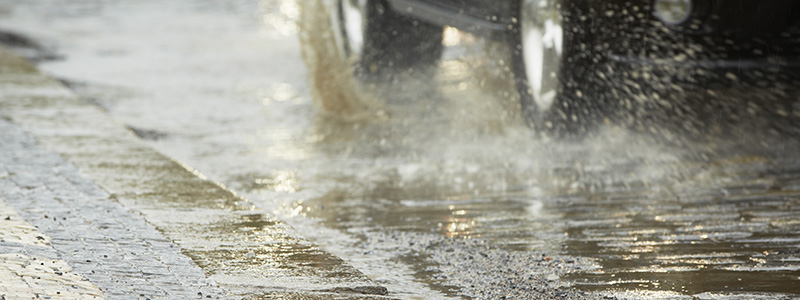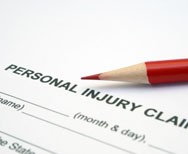Who is at Fault When Bad Weather Causes a Car Accident?
Certain weather conditions can cause even the most cautious and capable drivers to be involved in a car accident. When a situation like this occurs, it’s natural for the driver to feel that the accident was caused by the bad weather.
When all the facts are broken down, who is really at fault when the bad weather seems to be the source of the accident?
Along with the uncertainty of who is at fault, other questions arise pertaining to how liability is determined, if blaming the weather will hold up in court or not, what the insurance claim outcome will be, along with what steps should be taken after the accident occurs.

What is Considered a Weather-Related Auto Accident?
Firstly, we should determine what is normally deemed a weather-related accident. Bad weather, particularly in the winter, can produce hazardous conditions that may result in accidents that seem unavoidable. Car accidents in Ontario are typically elevated during the winter months due to the unsafe driving conditions that are produced.
The most common weather that contributes to these car accidents would be snow, ice (black ice in particular), rain (flooding), fog, and wind.
These inclement weather conditions can cause slippery roads, loss of vehicle control, and poor visibility, which therefore can easily make the driver decide the fault of the accident was due to the dangerous weather.
Claiming an accident due to bad weather as opposed to the driver accepting fault is not so far-fetched. The major auto insurer, Aviva Canada, released annual statistics that shows customer auto claims increased by 49% between December and February in comparison to the rest of year. This clearly shows that bad weather is a major contributor to auto accidents.

It’s worth mentioning that winter is not the only season that contributes to increased car accidents in Canada. Fall is known to produce slippery conditions due to wet fallen leaves, as well as early low visibility sunsets and foggy conditions. There are several fall driving tips you can utilize to ensure your drive is a safe one.
Who is Really Liable When You Feel Bad Weather is to Blame?
Unless there are special circumstances, when the weather seems to be the source of a car accident, the individual operating the vehicle will most likely be liable.
Yes, the dangerous weather conditions are what triggered the accident, but the driver is ultimately responsible due to the fact that he or she is required by law to operate their vehicle safely in all weather conditions.
Although each incident is unique with its own set of circumstances, it can be typical that the driver who loses control of their vehicle may be labeled the responsible party.
If multiple vehicles lose control at the same time due to dangerous road conditions and collide, depending on the circumstances, each party might only be held responsible for their own vehicle damages, as it would be considered a shared fault.
How is Liability Determined?
A key factor in determining liability in bad weather conditions is if the driver was negligent at the time of the car accident. Although the driver may feel they were not negligent, there are many elements that may not be apparent to the driver when it comes to the cause of the accident.
The term negligence, in this case, is typically referred to when a driver does not utilize proper caution in hazardous weather conditions. This can pertain to how the vehicle operator is driving to how their car has been equipped ahead of time to handle poor road conditions.
Driver’s actions that may be deemed negligence in bad weather
- An unsafe speed was driven that did not reflect the road conditions
- A turn was taken at an accelerated speed on slippery pavement
- Driver was not leaving enough distance between vehicles
- Failure to use headlights in poor visibility conditions
Negligence due to poor vehicle maintenance
- Worn tires
- Poor brakes
- Light(s) not functioning
- Ineffective windshield wipers
The negligence items listed give a good indication that it’s not just the bad weather itself that has caused the auto accident, but a combination of the driver’s skills, their vehicle’s current condition, and the poor road conditions.
Inclement Weather Insurance Claims – Will They be Approved or Denied?
When an insurance company reviews a bad weather claim, the first thing that will be considered is if the driver’s negligence was the ultimate source of the accident. Determining negligence and fault is a key role an insurance agent plays and the fault determination procedures can vary from office to office but are generally similar.
If an accident occurs in heavy rain and a driver’s negligence has been proven, the claim’s outcome would be similar to an auto accident that has occurred during perfect weather conditions. This is because it’s not the weather they are evaluating, it’s the driver’s performance and vehicle condition they are looking at.
Even if an individual was driving at a safe speed in icy conditions, and did everything correct, it can be determined that they should not have been driving in such extreme conditions in the first place. The insurance agent can also use the claim that they were the one that ultimately lost control of their vehicle.
When it comes to determining if your claim will be approved or denied, be prepared to have your insurance agent treat your case without regards to the fact that it took place in hazardous weather conditions. Rain, snow, ice, wind, or fog may not be the determining factor, your ability to keep the vehicle under control is what they will be accessing. With this being said, it may be a good idea to brush up on some basic road safety tips.

“The Weather Made Me Do It” Will it Stand up in Court?
If you have been determined at fault and decide to dispute this in court, be sure you have strong evidence that you are not liable because weather conditions alone will most likely not hold up in court.
Viable reasons to take your case to court would be if you believe another party was at fault, which could include another driver, a pedestrian, or the manufacturer of the car due to a defective part.
If you feel you have a strong case, it would be wise to seek out an attorney.
What Steps Should be Taken After the Accident?
It’s imperative that the appropriate steps be taken after you have experienced an accident related to bad weather. Not taking these steps may jeopardize your claim.
- Never Apologize: It’s recommended that you do not apologize to anyone at the scene of the accident, especially since you may not be aware of all the circumstances surrounding the accident. Apologizing could be viewed as admitting fault.
- Don’t Claim You are Not Hurt: At the time of the accident you may feel fine, but physical symptoms can occur hours, days, or weeks later. Your profession of not being hurt can be used as evidence against you.
- Take Photos: It would be wise to take photos of anything you feel will help your case. This could include skid marks caused by your car or others. You will also want to photograph the damage that has happened to your vehicle or any bodily injuries.
- Inform Your Insurance Company: Filing a claim with your insurance company is important if you plan on seeking accident benefits. Inform your insurance agent as soon as possible and be aware that there could be a time limit in your area for filing a claim. In Ontario, you must file your claim within 7 days.
- Visit Your Doctor: You should see your doctor to ensure you are not physically hurt and for insurance purposes. It’s recommended to be evaluated by a doctor as soon as possible after the accident.
- Read the Fine Print: If asked to sign an agreement, it’s crucial that you read every line. This especially holds true with documents obtained from your doctor. You will want to be sure there are no statements claiming that you are not injured, along with other factors that may hurt your case.
- Contact an Attorney: If you feel you are not at fault, a lawyer can assist you in building a strong case. This is especially imperative if there is considerable damage to your vehicle or bodily harm. An attorney has experience dealing with bad weather car accident claims and will know how to proceed with your case.
These 7 steps are essential to securing that your claim goes smoothly. Review this crash course of what to do if you have been in a car accident for an in-depth explanation of each step.
If You’ve Been in an Accident Related to Bad Weather, Contact Conte & Associates Today
We understand how difficult it can be when dealing with a bad weather-related car accident. You may feel you are not at fault and no one is listening to you.
Conte Jaswal will take the necessary action to ensure your facts are brought to the table. We have the knowledge and resources to access your case if you do in fact have grounds for a claim.
Contact us today for a free consultation!






